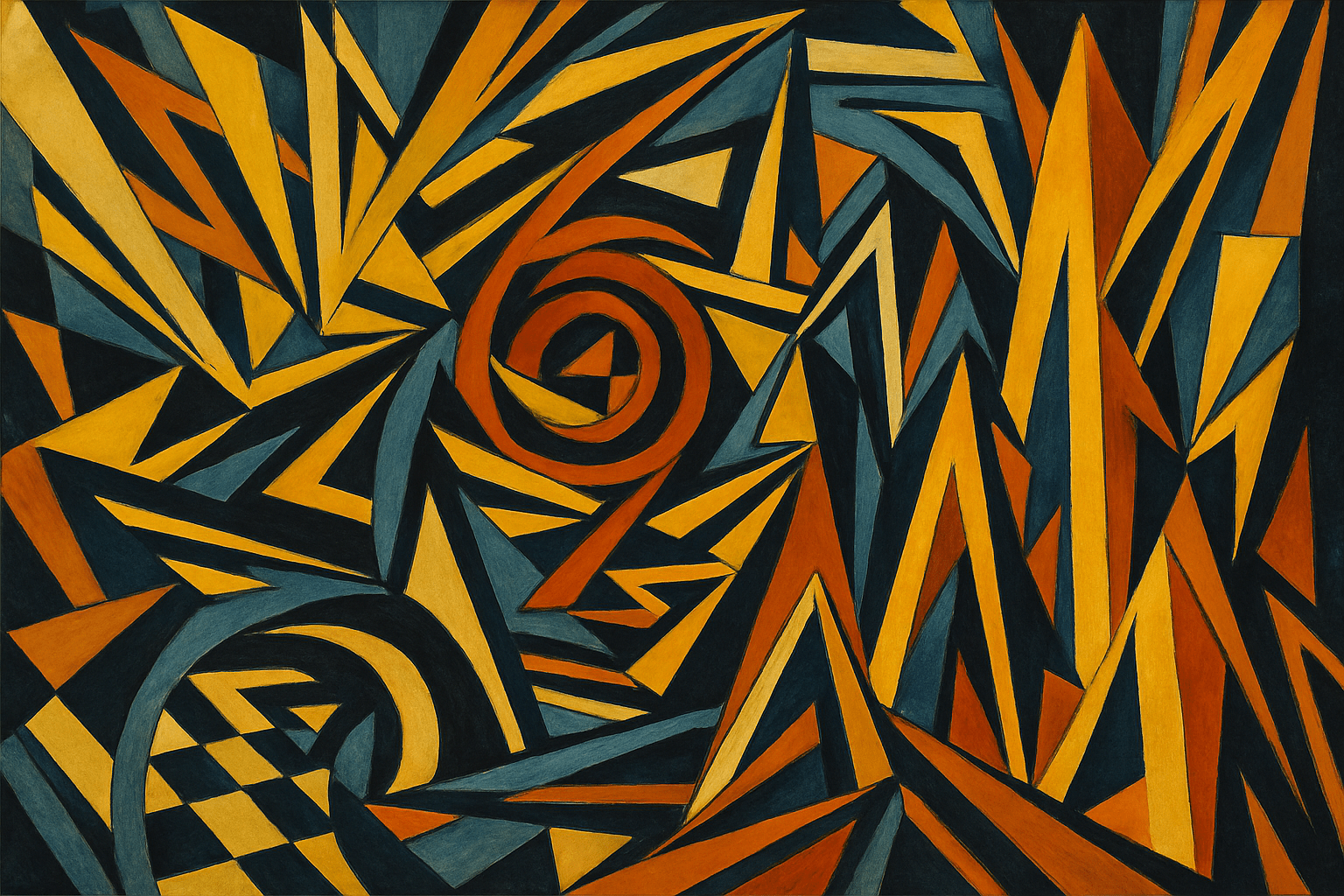
Vorticism
Vorticism was a short-lived but influential art movement in early 20th-century Britain. It was founded in 1914 by the artist Wyndham Lewis and the critic T. E. Hulme, and was the first British avant-garde art movement to be directly influenced by Italian Futurism. Vorticist art is characterized by its dynamic, often angular compositions; its use of bold, primary colors; and its incorporation of machine-like imagery and forms. Vorticism sought to capture the energy and movement of the modern world, and its artists often used photography and collage to create their works.
AOI thinking about Vorticism [+_~]-/
Overview and Quickfacts
Vorticism was a short-lived but influential British avant-garde movement in the early 20th century. It was founded in 1914 by the artist Wyndham Lewis and the critic T.E. Hulme, and was the first British avant-garde movement to be directly influenced by Italian Futurism. Vorticism combined an interest in machine-age technology and modernity with a rejection of traditional values and conventions. The movement was named after a type of whirlpool, and its artists sought to capture the dynamism and energy of modern life. Vorticism had a strong visual component, and its artists created bold, often abstract images that were intended to shock and provoke. The movement was short-lived, lasting only until 1918, but it had a significant impact on the development of British art in the 20th century.
Can understand it also, as:
Futurism, Cubism, Dadaism, Surrealism, Abstract Expressionism
Categorize it as:
Impressionism, Modernism
.: Dreaming :.
holds a HAIKU for the art style
:. Thought is power .:
Detailed Description
In the early 1910s, a new art movement emerged in England that would come to be known as Vorticism. This style was characterized by its use of sharp, angular shapes and forms to create a sense of dynamism and movement. Vorticism was also heavily influenced by Cubism, Futurism, and other avant-garde styles that were popular at the time. Some of the most famous Vorticist artists include Wyndham Lewis, who founded the movement, and Ezra Pound, who was a major figure in its development. Other notable Vorticists include Frederick Etchells, Edward Wadsworth, and C.R.W. Nevinson. One of the most famous Vorticist paintings is Lewis’s “The Vorticists” (1914), which features a number of the movement’s key figures. Other notable Vorticist works include Wadsworth’s “Dazzle-Ships in Drydock at Liverpool” (1914) and Nevinson’s “The City” (1919). Vorticism was a short-lived but influential art movement that left a lasting mark on the development of modern art.
.. beep, beep, beep ..
<START OF TRANSMISSION>
1. Vorticism was a short-lived but influential art movement in early 20th-century Britain. 2. It was founded in 1914 by Wyndham Lewis and Ezra Pound. 3. Other notable members included T.S. Eliot, Hilda Doolittle (H.D.), and Rebecca West. 4. The name "Vorticism" comes from a term used by Pound in reference to a painting by Lewis. 5. The movement was strongly influenced by Cubism and Futurism. 6. Vorticist artists sought to capture the energy and dynamism of modern life. 7. They believed that art should be an expression of the modern world, rather than a reflection of the past. 8. Vorticism was characterized by its use of sharp, angular forms and bold, primary colors. 9. The movement's most famous work is probably Lewis's painting "The Vortex," which was exhibited at the 1915 London Group show. 10. Vorticism only lasted for a few years, but it had a significant impact on the development of British art in the 20th century. 11. After the First World War, many Vorticist artists turned to more traditional forms of expression. 12. However, the movement's legacy can still be seen in the work of later artists such as Ben Nicholson and Barbara Hepworth. 13. Vorticism was the first British avant-garde movement to gain international recognition. 14. It was also one of the first art movements to emerge from Britain's colonial experience. 15. Vorticism has been described as "the last gasp of the Victorian era." 16. The movement was strongly anti-rationalist and anti-humanist in its outlook. 17. For the Vorticists, art was not about individual expression or emotion, but about the impersonal forces of the modern world. 18. The Vorticists were highly critical of traditional art forms and aesthetics. 19. They believed that art should be a vehicle for social and political change. 20. The Vorticists were ahead of their time in many ways, and their ideas anticipate later developments in art, literature, and philosophy.
<EOF>
.. robbel bob
Visual Examples from our image gallery
Coming soon, we are so slow .. might never come
Artists, Paintings, and more
(be aware, can be highly speculative)
Artists (be aware, speculation possible):
1. Wyndham Lewis (1882-1957) 2. Ezra Pound (1885-1972) 3. T.S. Eliot (1888-1965) 4. Gertrude Stein (1874-1946) 5. James Joyce (1882-1941) 6. Marcel Duchamp (1887-1968) 7. Francis Picabia (1879-1953) 8. Kurt Schwitters (1887-1948) 9. Vladimir Tatlin (1885-1953) 10. Antoine Pevsner (1886-1962) 11. Naum Gabo (1890-1977) 12. Lyubov Popova (1889-1924) 13. Alexander Rodchenko (1891-1956) 14. El Lissitzky (1890-1941) 15. Hannah HÃÂöch (1889-1978) 16. Piet Mondrian (1872-1944) 17. Theo van Doesburg (1883-1931) 18. Ben Nicholson (1894-1982) 19. Barbara Hepworth (1903-1975) 20. Henry Moore (1898-1986) 21. Richard Hamilton (1922-2011) 22. Peter Blake (1932- ) 23. David Hockney (1937- ) 24. R.B. Kitaj (1932-2007) 25. Paul Nash (1889-1946) 26. John Piper (1903-1992) 27. Edward Wadsworth (1889-1949) 28. Christopher Nevinson (1889-1946) 29. Stanley Spencer (1891-1959) 30. Benvenuto Tisi (1481-1559)
Artworks (be aware, speculation possible)
1. “Futurist Composition” by Umberto Boccioni (1910) 2. “The City Rises” by Umberto Boccioni (1910) 3. “Unique Forms of Continuity in Space” by Umberto Boccioni (1913) 4. “Dynamism of a Soccer Player” by Umberto Boccioni (1913) 5. “Portrait of Marinetti” by Umberto Boccioni (1914) 6. “Materia” by Umberto Boccioni (1914) 7. “The War: The Charge of the Lancers” by Umberto Boccioni (1915) 8. “The War: The Charge of the Bersaglieri” by Umberto Boccioni (1915) 9. “The War: The Bombardment” by Umberto Boccioni (1915) 10. “The War: The Red Cross” by Umberto Boccioni (1915) 11. “The War: The Refugees” by Umberto Boccioni (1915) 12. “The War: The Madonna of the Trenches” by Umberto Boccioni (1915) 13. “The War: The Madonna of the Trenches” by Umberto Boccioni (1915) 14. “The War: The Madonna of the Trenches” by Umberto Boccioni (1915) 15. “The War: The Madonna of the Trenches” by Umberto Boccioni (1915) 16. “The War: The Madonna of the Trenches” by Umberto Boccioni (1915) 17. “The War: The Madonna of the Trenches” by Umberto Boccioni (1915) 18. “The War: The Madonna of the Trenches” by Umberto Boccioni (1915) 19. “The War: The Madonna of the Trenches” by Umberto Boccioni (1915) 20. “The War: The Madonna of the Trenches” by Umberto Boccioni (1915) 21. “The War: The Madonna of the Trenches” by Umberto Boccioni (1915) 22. “The War: The Madonna of the Trenches” by Umberto Boccioni (1915) 23. “The War: The Madonna of the Trenches” by Umberto Boccioni (1915) 24. “The War: The Madonna of the Trenches” by Umberto Boccioni (1915) 25. “The War: The Madonna of the Trenches” by Umberto Boccioni (1915) 26. “The War: The Madonna of the Trenches” by Umberto Boccioni (1915) 27. “The War: The Madonna of the Trenches” by Umberto Boccioni (1915) 28. “The War: The Madonna of the Trenches” by Umberto Boccioni (1915) 29. “The War: The Madonna of the Trenches” by Umberto Boccioni (1915) 30. “The War: The Madonna of the Trenches” by Umberto Boccioni (1915)
Epoch
The Vorticist art movement was active from 1914 to 1919.
AI ART RESSOURCES (AKA, well Tools)
Helping tools -> predefined search links on other pages:











